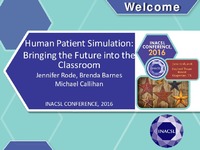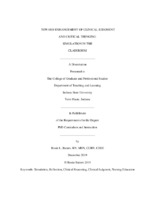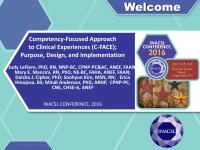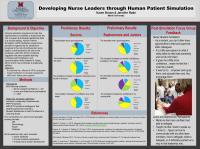| dc.contributor.author | Rode, Jennifer L. | en |
| dc.contributor.author | Barnes, Brenda | en |
| dc.contributor.author | Callihan, Mike | en |
| dc.date.accessioned | 2016-08-11T16:05:11Z | |
| dc.date.available | 2016-08-11T16:05:11Z | |
| dc.date.issued | 2016-08-11 | |
| dc.identifier.uri | http://hdl.handle.net/10755/618298 | |
| dc.description | <p>Annual Simulation Conference. Held at the Gaylord Texan Resort & Convention Center</p> | en |
| dc.description.abstract | <p>Evidence supports the contributions of high-fidelity HPS to post-simulation affective, cognitive, and psychomotor learning outcomes (Cant & Cooper, 2010; Lapkin, Levett-Jones, Bellchambers & Fernandez, 2010). Expanding the benefits of HPS experiences to more students and with more experiences would multiply these benefits. However, to justify the full integration of HPS into nurse curriculum, more evidence of knowledge retention is needed. Few studies examine how well information learned in HPS remains 3-6 months following the HPS experience, and existing evidence is limited and inconsistent (Ackermann, 2009; Aqel & Ahmad, 2014; Couto, Farhat, Geis, Olsen & Schvartsman, 2015).Further, a more efficient strategy to deliver HPS to large groups of students is essential to feasibly adapt HPS to dwindling numbers of nurse faculty. One of the biggest challenges in expanding HPS experiences is the time needed to facilitate HPS for large groups of students (Adamson, 2010). New strategies are needed to address this barrier. Using a quasi-experimental design, we developed and tested a large-group HPS experience to minimize time required for HPS experiences by capturing the value of vicarious learning. Our intervention included 8 high-fidelity HPS scenarios embedded into a didactic medical-surgical undergraduate nursing course. We describe our large-group HPS intervention and present tools we used to assist students with the new teaching-learning strategy. Using results from MANCOVA and t-test analyses, we present evidence of knowledge retention, compared to traditional teaching methods; and we examine the effects of this strategy for both active participants and vicarious learners who observe the high-fidelity HPS experience</p> | en |
| dc.format | Text-based Document | en |
| dc.language.iso | en | en |
| dc.subject | Clinical Simulation | en |
| dc.subject | Large Group | en |
| dc.subject | Quantitative Research | en |
| dc.title | Human patient simulation: Bringing the future into the classroom | en |
| dc.type | Presentation | en |
| dc.rights.holder | <p>
All rights reserved by the author(s) and/or publisher(s) listed in this item record unless relinquished in whole or part by a rights notation or a Creative Commons License present in this item record.
</p><p>
All permission requests should be directed accordingly and not to the Sigma Repository.
</p><p>
All submitting authors or publishers have affirmed that when using material in their work where they do not own copyright, they have obtained permission of the copyright holder prior to submission and the rights holder has been acknowledged as necessary.
</p> | en |
| dc.description.note | <p>Items submitted to a conference/event were evaluated/peer-reviewed at the time of abstract submission to the event. No other peer-review was provided prior to submission to the Henderson Repository, unless otherwise noted.</p> | en |
| dc.type.category | Full-text | en |
| dc.evidence.level | N/A | en |
| dc.research.approach | N/A | en |
| dc.author.details | Jennifer L. Rode, PhD, MSN, RN; Brenda Barnes, MSN, RN; Mike Callihan, MSN, RN | en |
| dc.conference.name | International Nursing Association for Clinical Simulation and Learning Annual Conference 2016 | en |
| dc.conference.host | International Nursing Association for Clinical Simulation and Learning | en |
| dc.conference.location | Grapevine, Texas, USA | en |
| dc.date.conferenceyear | 2016 | |
| dc.contributor.affiliation | International Nursing Association for Clinical Simulation and Learning (INACSL) | en |
| dc.description.reviewtype | Abstract Review Only: Reviewed by Event Host | en |
| dc.description.acquisition | Proxy-submission | en |





